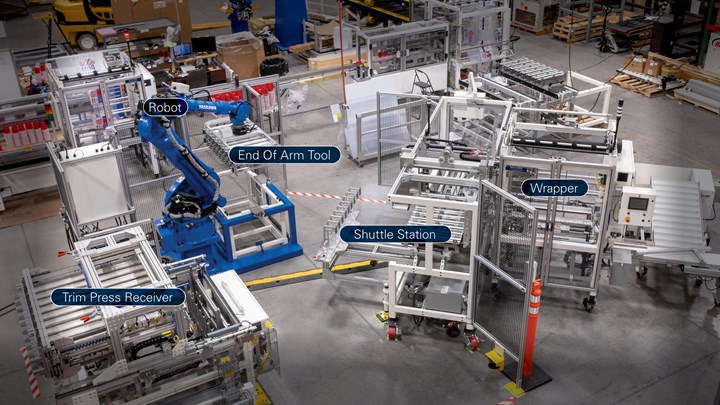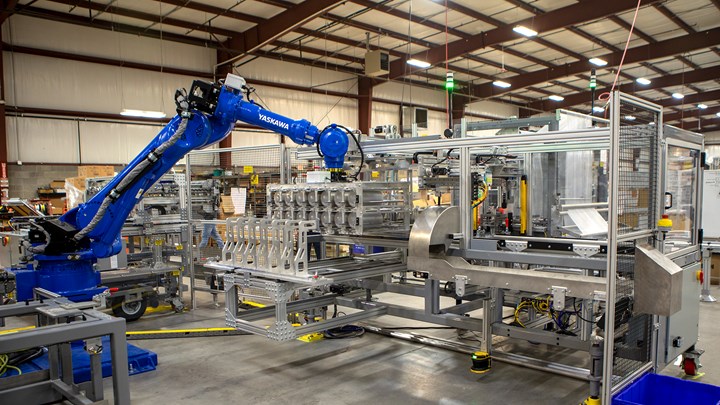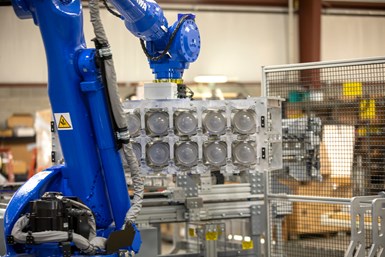Thermoformers running non-servo-eject trim presses will have access to a first-of-its kind automation solution thanks to new technology introduced recently by BMG. Its Mantis Robotic Trim Press Handler was developed by NAS Nalle Automation Systems, a BMG company, and is billed as the industry’s first robotic system that reliably handles the flow of parts ejected from any non-servo trim press, including those made by BMG competitors. The fully automated system reportedly can reduce labor requirements by up to 75%, and the modular robotic design allows for tool changeovers in under an hour. Mantis has been running since March at an undisclosed Midwest thermoformer on a line making PP lids.
Before this innovation, parts ejected from non-servo trim presses had to be manually separated and counted, a labor-intensive, error-prone and inconsistent process that limits the automation of downstream packaging functions. NAS solved this problem with its patent-pending Trim Press Receiver (TPR), which uses a unique separating mechanism to count and contain stacks of product, followed by a raking mechanism to take the product into the receiver for transfer by the robot.

Photo shows various components of the new Mantis Robotic Trim Press Handler. (Photos: BMG)
Kurt Huelsman, president of NAS, calls the TPR the “core of the line.” As he explains, “Being able to cut into the ‘deck of cards’ of multiple lanes of product, separate them, and then contain them as they are pulled off the trim press while it is still running does not sound hard. But no one has ever done it effectively before. Mantis can handle products that have been relegated to non-servo eject because they are hard to handle, such as lids, which don’t nest well. Without the TPR, we have a nice robotic handler. With it, we have a non-servo-eject system that can handle products previously unable to be automated. The future of thermoforming is for automation to be built in, not simply an option or accessory.”
“The future of thermoforming is for automation to be built in, not simply an option or accessory.”
He adds, “Consistent and reliable separation of product on a continuously flowing, non-servo-eject trim press was the key to the development of Mantis. The design of the receiver, coupled with NAS’s robotic automation capabilities, brings a safe, productive and cost-effective solution to a historically very manual process.”
How it Works
As Jon Smalling, director of automation for NAS, explains, the TPR is butted up against the trim press. Raking and separating mechanisms within the TPR collect parts, which are presented to a six-axis robot equipped with product-matching, quick-change end-of-arm tooling (EOAT). The robot automatically transfers product to a Shuttle Station, which, after kicking out mis-trim or off-spec parts, integrates with downstream packaging functions that include wrapping, boxing, case packing, sealing and palletizing. Incorporating the robot allows the Mantis system to be very compact and configurable, making installation possible where floor space is limited or obstructed, BMG says.

Here, the Mantis robot transfers lids from the TPR to the shuttle.
BMG bills Mantis as configurable and adaptable. Explains Huelsman, “First of all, we can work with non-servo eject and servo trim presses from any supplier; the TPR interface designed for a BMG trim press would be different than for other brands. So there will be features to the TPR that will be unique to the particular trim press in terms of fixturing, attachments, etc. Adds Smalling, “The TPR takes up about the same space as operator interaction, if not less. Remember, a typical thermoforming plant has to allot space for three to five humans for pulling, separating and counting stacks of product. Our robot and shuttle station are completely reconfigurable. We’ve designed a system that can ‘dance around’ any existing footprint.”
Introduction of Mantis comes at a time when processors of all kinds are looking for automation solutions to improve efficiencies and mitigate ongoing worker shortages. Notes Bob Gordert, BMG’s v.p. sales for the Americas. “On the post-trim side, a very large percentage of our customers are requiring downstream automation to justify new thermoforming equipment in order to achieve their ROI and to mitigate exposure to workforce shortages.”

Close-up of Mantis robot with quick-change toll transferring lids that had been separated and stacked in TPR.
“We are excited about the first installation of the Mantis Robotic Trim Press Handler from NAS,” says Paul Phillips, BMG’s v.p. marketing. “The system will help thermoformers keep their lines running despite the labor shortages they are facing. The Mantis offers quick product changeovers and full product containment from the Trim Press to the bagger, all within a compact footprint with minimal human interaction. We fully expect the Mantis to provide themoformers with more uptime and reliable trim-press handling that grows with their business.”
“Our robot and shuttle station are completely reconfigurable. We’ve designed a system that can ‘dance around’ any existing footprint.”
Gordert says the partnership with its beta customer made sense because this particular thermoformer was committed to testing the TPR, its connection to the trim press (a non-BMG machine), and its ability to strip, rake and contain the product all the way through the robot tool. The installation went “smoothly, with minimal issues.” Huelsman says Mantis was up and running within two to three days and running around the clock within five days.
Optional features offered with the Mantis include remote monitoring for preventive maintenance, predictive maintenance, cycle-time analysis and other functions.

Mantis EOAT feeding lids to shuttle station.
The BMG Group is made up of Brown, Lyle, GN, Freeman (a supplier of thermoform tooling), NAS, and aXatronics. The latter is a certified Motoman Robotics strategic partner that focuses on creating high-level mechatronics process-engineered solutions for challenging processes in manufacturing. NAS, a 25-yr-old company, was acquired by BMG in 2016.
Related Content
Novel ‘Clamtainer’ Extends Thermoformer's Reach in Packaging
Uniquely secure latching expands applications for Jamestown Plastics’ patented clamshell package design.
Read MoreAutomation in Thermoforming on the Rise
Equipment suppliers’ latest innovations exemplify this trend driven by factors such as labor shortages, higher-speed thermoformers and tighter quality control.
Read MoreThermoformer Maximizes Productivity with 3D Printing
Productive Plastics has created an extensive collection of 3D printed manufacturing aids that sharply reduce lead times.
Read MoreManufacturer Helps Clean Up Global Waterways with Reclaimed Plastics
RSP and Oceanworks partnership diverts plastic wastes from waterways for incorporation into new products.
Read MoreRead Next
How Polymer Melts in Single-Screw Extruders
Understanding how polymer melts in a single-screw extruder could help you optimize your screw design to eliminate defect-causing solid polymer fragments.
Read MoreAdvanced Recycling: Beyond Pyrolysis
Consumer-product brand owners increasingly see advanced chemical recycling as a necessary complement to mechanical recycling if they are to meet ambitious goals for a circular economy in the next decade. Dozens of technology providers are developing new technologies to overcome the limitations of existing pyrolysis methods and to commercialize various alternative approaches to chemical recycling of plastics.
Read MoreWhy (and What) You Need to Dry
Other than polyolefins, almost every other polymer exhibits some level of polarity and therefore can absorb a certain amount of moisture from the atmosphere. Here’s a look at some of these materials, and what needs to be done to dry them.
Read More



























